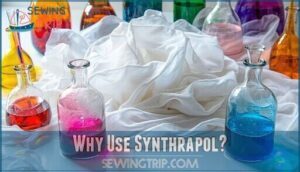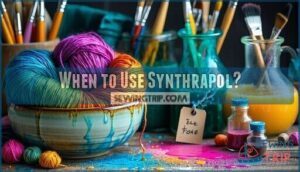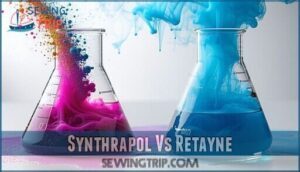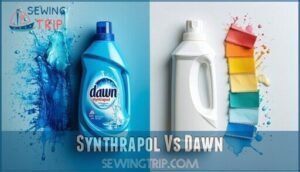This site is supported by our readers. We may earn a commission, at no cost to you, if you purchase through links.
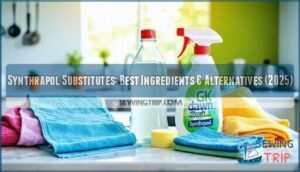 You’ll find several effective synthrapol substitutes ingredients in your home right now.
You’ll find several effective synthrapol substitutes ingredients in your home right now.
White vinegar mixed with water creates a pH-neutral solution that removes excess dye without harsh chemicals. Mild dish soap like Dawn works well for fabric washing, though it’s less specialized.
Professional alternatives include GK Craft Synthrapol Substitute, which mimics the original formula’s surfactant properties. For delicate fabrics, you can’t beat a gentle mixture of one part vinegar to four parts water.
These substitutes work by breaking surface tension and lifting dye particles, just like the real deal. The key lies in understanding which alternative matches your specific fabric type and project needs.
Table Of Contents
- Key Takeaways
- What is Synthrapol Used For?
- Why Use Synthrapol?
- When to Use Synthrapol?
- Synthrapol Ingredients
- Synthrapol Detergent Alternatives
- Best Synthrapol Substitute
- Does Synthrapol Go Bad?
- Synthrapol Vs Retayne
- Synthrapol Vs Dawn
- Where to Buy Synthrapol Detergent
- Frequently Asked Questions (FAQs)
- Conclusion
Key Takeaways
- You can create effective Synthrapol substitutes using common household items like white vinegar mixed with water (1:4 ratio) or Dawn dish soap, which work by breaking surface tension and lifting dye particles just like the original product.
- You’ll need different substitutes for different purposes – use vinegar solutions for gentle dye removal on delicate fabrics, Dawn for oil removal, and specialized alternatives like Dharma Professional Textile Detergent for serious dyeing projects.
- You should apply these substitutes at three key stages: pre-dyeing to remove oils and sizing, during dye baths to prevent bleeding, and post-dyeing to wash out excess dye particles that could cause future color problems.
- You’ll get the best results by understanding that Synthrapol’s neutral pH and surfactant properties protect delicate fibers like silk and wool, so choose substitutes that won’t damage your specific fabric types or interfere with dye reactions.
What is Synthrapol Used For?
Synthrapol’s versatility makes it your go-to solution for fabric dyeing projects.
You’ll use it as a dyeing pre-wash to strip oils and sizing from new fabric, ensuring better dye adherence.
It prevents color bleeding by suspending loose dye particles that would otherwise stain your fabric.
When added to dye baths, it acts as a wetting agent for complete fiber saturation.
This specialized detergent for fabric excels at removing excess reactive dyes after dyeing, preventing back-staining.
Its neutral pH protects delicate fibers like silk and wool while enhancing color vibrancy.
Whether you’re pre-scouring, adding to dye vats, or washing finished pieces, Synthrapol keeps colors true.
While substitutes exist, understanding its primary functions helps you choose the right alternative; similarly, using thread conditioner benefits sewing projects by reducing friction.
Why Use Synthrapol?
Professional dyers swear by specialized detergents because they deliver results that regular soap can’t match. When you’re investing time and materials in fabric projects, you need reliable dyeing advantages that protect your work.
Professional dyers know: specialized detergents deliver results that regular soap simply can’t match.
Here’s why fiber preparation matters for your projects:
- Colorfastness boost: Prevents colors from bleeding during future washes
- Gentle cleaning: Removes oils without damaging delicate fibers like silk and wool
- pH balance: Maintains neutral conditions that won’t interfere with dye reactions
Synthrapol substitutes offer these same benefits while preparing your fabric for maximum dye absorption. Quilters may also appreciate the fabric’s tear resistance, making it ideal for long-lasting projects. Smart alternatives guarantee vibrant, lasting results every time.
When to Use Synthrapol?
Timing makes all the difference when working with fabric dyes. You’ll want to reach for Synthrapol during three key moments in your dyeing journey.
Pre-dyeing preparation is vital—soak your fabric in Synthrapol to remove oils, sizing, and other barriers that prevent even dye absorption. This step guarantees your colors penetrate deeply and uniformly across different fiber types, from cotton to silk.
During dye baths, add Synthrapol to prevent color bleeding between sections and improve dye penetration. After dyeing comes the critical wash-out phase.
Use Synthrapol to remove excess dye particles that could cause future bleeding or muddy colors. This is especially important for reactive dyes on cellulose fibers.
For smoother stitching, consider using thread to reduce friction. Consider Synthrapol substitutes or detergent alternatives if you’re seeking a dye fixative substitute for specific projects requiring gentler treatment.
Synthrapol Ingredients
Understanding what’s inside Synthrapol helps you pick better substitutes when you’re in a pinch.
This specialized detergent packs a chemical punch that regular soaps can’t match.
Here’s what makes Synthrapol tick:
- Water – Base solvent that carries all active ingredients
- Isopropanol (5-10%) – Alcohol content breaks down oils and waxes
- Sodium dodecylbenzene sulphonate (15-20%) – Primary surfactant types for deep cleaning
- Ethoxylated compounds – Enhanced penetration agents
- pH neutral formulation – Protects delicate fibers
The brighteners absence keeps your dark colors true, while surfactants handle lanolin removal from wool.
Synthrapol also functions to improve dye penetration itself during the dyeing process.
This pH level won’t damage silk or protein fibers like harsh alternatives might.
Synthrapol Detergent Alternatives
Now that you understand Synthrapol’s composition, let’s explore practical alternatives that won’t break the bank.
Many household items can serve as effective Synthrapol substitutes when you’re dealing with dye bleeding issues.
Several DIY Synthrapol options deliver impressive results:
- Dawn dish soap – Creates a pH neutral detergent that suspends loose dye particles
- White vinegar mixed with salt – Natural combination that prevents color transfer between fibers
- Baking soda solution – Gentle scouring agent that removes oils without fabric damage
- Unscented laundry detergent – Cost-effective alternative for basic dye removal needs
Using Synthrapol helps with dye suspension, preventing backstaining during fabric dyeing.
Test these natural alternatives on fabric scraps first to confirm effectiveness before committing to larger projects.
Best Synthrapol Substitute
After exploring various DIY alternatives, Dharma Professional Textile Detergent stands out as the top synthrapol alternative for serious fabric dyers. This specialized formula offers excellent fiber compatibility across cotton, silk, wool, and synthetic materials without breaking the bank.
Professional textile detergent that rivals Synthrapol’s performance while keeping your wallet happy and your fabrics vibrant.
When effectiveness testing reveals you need consistent results, this substitute delivers. It removes sizing and oils just like the original, preparing your fabrics for vibrant dye absorption. The pH-neutral formula won’t damage delicate fibers, making it perfect for both beginners and experienced crafters.
Many crafters find that Elmer’s glue works as a temporary fix. Cost comparison shows it’s often more affordable than brand-name options while maintaining professional-grade performance. Plus, its environmental impact remains minimal thanks to biodegradable ingredients.
You’ll find Synthrapol substitutes like this one work seamlessly in pre-wash treatments and post-dye cleanup. For reliable alternatives that won’t let you down mid-project, stick with proven ingredients designed specifically for textile work rather than household detergents.
Does Synthrapol Go Bad?
While exploring the best Synthrapol substitutes, you might wonder about your current bottle’s shelf life. Good news – Synthrapol doesn’t go bad quickly when stored properly.
This specialized detergent maintains its effectiveness for years under proper storage conditions. Keep your bottle sealed tightly, store it at room temperature, and avoid direct sunlight. These simple steps preserve the surfactant’s cleaning power indefinitely. Like sewing machine oil, Synthrapol quality can degrade, so you should monitor clarity and viscosity over time.
Watch for these degradation signs that indicate reduced effectiveness:
- Color changes – Any unusual discoloration suggests chemical breakdown
- Texture alterations – Clumping or separation indicates compromised quality
- Reduced cleaning power – Less effective dye removal means it’s time for replacement
Even older Synthrapol retains some cleaning ability, though you’ll notice effectiveness change over time. The neutral pH formula resists spoilage better than many alternatives. When disposal becomes necessary, small amounts can go down the drain, while larger quantities need proper hazardous waste disposal methods.
Synthrapol Vs Retayne
Choosing between Synthrapol and Retayne isn’t rocket science, but understanding their differences saves you from fabric disasters.
These products tackle dye fixation from opposite angles in the colorfastness showdown.
| Feature | Synthrapol | Retayne |
|---|---|---|
| Primary Function | Removes excess dye particles | Sets existing dye permanently |
| Application Timing | After dyeing/quilting completion | Before cutting and piecing |
| Chemical Composition | Neutral pH surfactant | Acidic dye-bonding agent |
| Best Use Cases | Washing out loose dye | Preventing future bleeding |
| Cost Effectiveness | Budget-friendly for large projects | Economical for small batches |
Synthrapol substitutes work great for post-dye cleanup, while Retayne alternatives excel at prevention.
Considering the project, note that polyester offers strength and durability.
Synthrapol Vs Dawn
Unlike Retayne’s dye-setting focus, comparing Dawn and Synthrapol reveals key differences in cleaning power and fiber safety.
Both contain surfactants that suspend loose dye particles, but their formulations serve different purposes.
| Feature | Dawn Dish Soap | Synthrapol |
|---|---|---|
| Primary Use | Grease removal | Textile processing |
| Cleaning Power | Cuts through oils/fats | Removes sizing/excess dye |
| Fiber Safety | Can strip existing dyes | Formulated for delicate fibers |
| Cost Comparison | Half the price | Premium textile detergent |
| Environmental Impact | Household-grade formula | Professional textile concentrate |
Dawn excels at degreasing but may damage dyed fabrics through aggressive cleaning action.
Synthrapol’s neutral pH protects fiber integrity while removing unwanted dye particles.
For textile detergent alternatives, Dawn works as a Synthrapol substitute for basic cleaning, though user preference often favors specialized products for serious dyeing projects.
Considering fabric types, rayon offers breathability that some synthetics lack.
Where to Buy Synthrapol Detergent
You’ll find Synthrapol at major Online Retailers like Amazon and Dharma Trading, which offer convenient delivery options.
Local Suppliers including craft stores like Blick Art Materials and specialty quilting shops often stock it too.
When shopping around, Price Comparison becomes essential since shipping costs can quickly add up.
Consider Bulk Purchasing if you’re dyeing frequently—it’s more cost-effective than buying small bottles repeatedly.
For general projects, you might even find suitable options where to buy sewing thread, as polyester threads provide durability.
However, before committing to large quantities, test Synthrapol substitutes and alternatives like Professional Textile Detergent or Orvus Paste, which might save you money while delivering similar results for your fabric projects.
Frequently Asked Questions (FAQs)
What is a good substitute for synthrapol?
Like finding a backup dancer for your main act, you’ll want a reliable substitute when Synthrapol isn’t available.
Dawn dishwashing liquid works perfectly—it cuts oils and removes excess dye effectively without harsh chemicals, making it a suitable alternative when Synthrapol is not available.
What are the ingredients in synthrapol?
Synthrapol contains water as its base, plus isopropyl alcohol (rubbing alcohol), sodium lauryl sulfate, sodium laureth sulfate, and cocamidopropyl betaine.
These ethoxylated and sulfated aliphatic alcohols create the surfactant action you need.
Can you use synthrapol as a surfactant?
Yes, you can absolutely use Synthrapol as a surfactant.
It’s specifically designed as a wetting agent that reduces surface tension, helping dyes penetrate fibers more effectively and ensuring even color distribution throughout your fabric. Even color distribution throughout your fabric.
Why is synthrapol better than other detergents?
Waiting reveals the secret: you’ll discover Synthrapol’s neutral pH won’t damage delicate silk or wool.
Lacks optical brighteners keeping dark colors true, and prevents dye migration—unlike regular detergents that can fade or harm your precious fabrics.
Should I use retayne & synthrapol?
You’ll get better results using both products together.
Retayne fixes existing dye to prevent bleeding, while Synthrapol removes excess dye particles.
They’re complementary—not competing—solutions for different fabric dyeing challenges, using Retayne to address specific needs.
What is synthrapol used for?
Like a fabric whisperer, this specialized detergent prepares your cloth for dyeing success.
You’ll use it to pre-wash fabrics, remove excess dye afterward, and prevent color bleeding between different hues during your creative projects.
What Are Some Easy Homemade Synthrapol Substitutes I Can Make at Home?
You can mix one part white vinegar with two parts water, or combine dish soap with baking soda. Regular laundry detergent works too—just rinse thoroughly afterward to remove residue.
Is Synthrapol Safe to Use on Silk and Wool?
Like silk gloves protecting delicate hands, Synthrapol’s neutral pH gently cleanses silk and wool without damage.
You’ll find it’s specifically formulated for protein fibers, removing excess dye while preserving these materials’ natural properties perfectly, with protein fibers being a key focus.
Where Can I Buy Synthrapol Substitute Products Locally?
You’ll find Synthrapol substitutes at craft stores like Michaels or Jo-Ann Fabrics.
Check fabric shops, quilting stores, and online retailers.
Professional Textile Detergent, Orvus Paste, and specialized dye suppliers offer similar products locally.
How Should I Dispose of Used Synthrapol Detergent?
Contrary to harsh chemical disposal fears, you can safely pour used Synthrapol down your drain. It’s non-toxic and breaks down in wastewater treatment systems, making disposal straightforward and environmentally responsible.
Conclusion
Finding fantastic synthrapol substitutes ingredients doesn’t require complicated chemistry knowledge.
You’ve discovered that white vinegar, Dawn dish soap, and specialized craft products can effectively replace expensive commercial options.
Whether you’re washing delicate silks or removing stubborn dye bleeding, these alternatives deliver reliable results.
Start with the vinegar-water mixture for most projects, then upgrade to professional substitutes when tackling challenging fabrics.
Your dyeing adventures just became more affordable and accessible.

